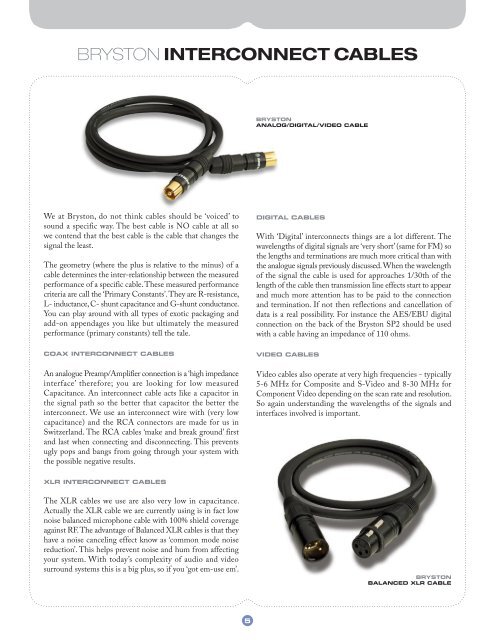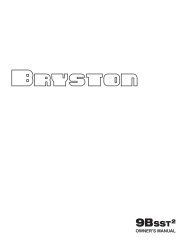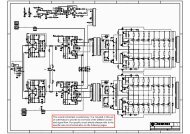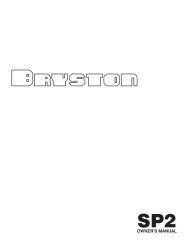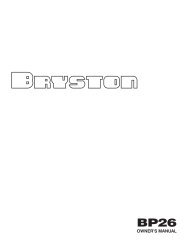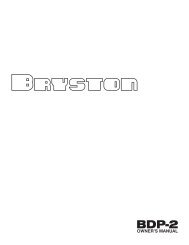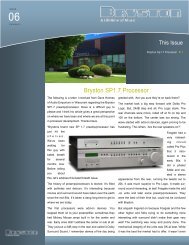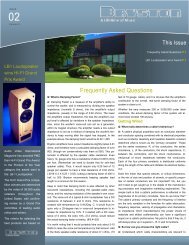Download Brochure (PDF) - Bryston
Download Brochure (PDF) - Bryston
Download Brochure (PDF) - Bryston
You also want an ePaper? Increase the reach of your titles
YUMPU automatically turns print PDFs into web optimized ePapers that Google loves.
BRYSTON INTERCONNECT CABLESBRYSTONANALOG/DIGITAL/VIDEO CABLEWe at <strong>Bryston</strong>, do not think cables should be ‘voiced’ tosound a specific way. The best cable is NO cable at all sowe contend that the best cable is the cable that changes thesignal the least.The geometry (where the plus is relative to the minus) of acable determines the inter-relationship between the measuredperformance of a specific cable. These measured performancecriteria are call the ‘Primary Constants’. They are R-resistance,L- inductance, C- shunt capacitance and G-shunt conductance.You can play around with all types of exotic packaging andadd-on appendages you like but ultimately the measuredperformance (primary constants) tell the tale.DIGITAL CABLESWith ‘Digital’ interconnects things are a lot different. Thewavelengths of digital signals are ‘very short’ (same for FM) sothe lengths and terminations are much more critical than withthe analogue signals previously discussed. When the wavelengthof the signal the cable is used for approaches 1/30th of thelength of the cable then transmission line effects start to appearand much more attention has to be paid to the connectionand termination. If not then reflections and cancellation ofdata is a real possibility. For instance the AES/EBU digitalconnection on the back of the <strong>Bryston</strong> SP2 should be usedwith a cable having an impedance of 110 ohms.COAX INTERCONNECT CABLESAn analogue Preamp/Amplifier connection is a ‘high impedanceinterface’ therefore; you are looking for low measuredCapacitance. An interconnect cable acts like a capacitor inthe signal path so the better that capacitor the better theinterconnect. We use an interconnect wire with (very lowcapacitance) and the RCA connectors are made for us inSwitzerland. The RCA cables ‘make and break ground’ firstand last when connecting and disconnecting. This preventsugly pops and bangs from going through your system withthe possible negative results.VIDEO CABLESVideo cables also operate at very high frequencies - typically5-6 MHz for Composite and S-Video and 8-30 MHz forComponent Video depending on the scan rate and resolution.So again understanding the wavelengths of the signals andinterfaces involved is important.XLR INTERCONNECT CABLESThe XLR cables we use are also very low in capacitance.Actually the XLR cable we are currently using is in fact lownoise balanced microphone cable with 100% shield coverageagainst RF. The advantage of Balanced XLR cables is that theyhave a noise canceling effect know as ‘common mode noisereduction’. This helps prevent noise and hum from affectingyour system. With today’s complexity of audio and videosurround systems this is a big plus, so if you ‘got em-use em’.BRYSTONBALANCED XLR CABLE5


